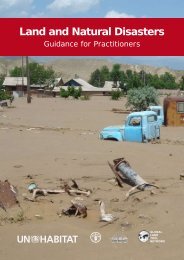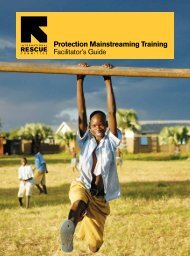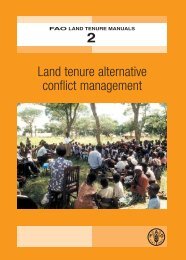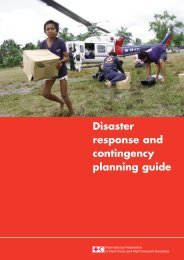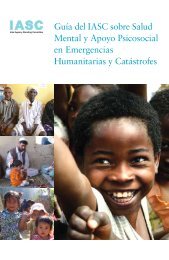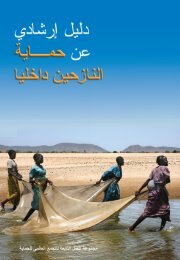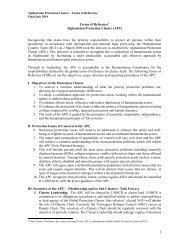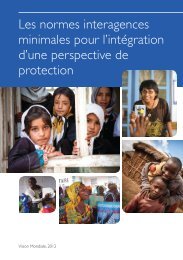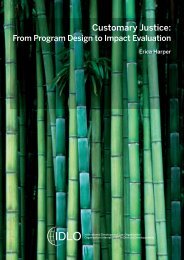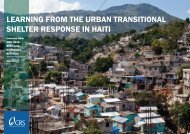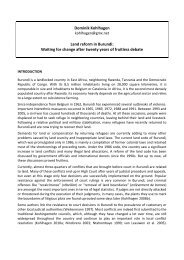Inter-Agency Real Time Evaluation of the Response to Cyclone Nargis
Inter-Agency Real Time Evaluation of the Response to Cyclone Nargis
Inter-Agency Real Time Evaluation of the Response to Cyclone Nargis
Create successful ePaper yourself
Turn your PDF publications into a flip-book with our unique Google optimized e-Paper software.
3 Findings and Recommendations3.1 ConsultationReviews <strong>of</strong> agency reports as well as interviews <strong>of</strong> agency staff and communities highlight somesignificant efforts <strong>to</strong> consult communities regarding <strong>the</strong>ir needs and priorities (e.g. <strong>the</strong> PONJA andFAO household surveys). However, while <strong>the</strong>re have been consultations at <strong>the</strong> village level,communication flows tend <strong>to</strong> be one-way (upwards), with little or no feedback <strong>to</strong> communities. Withfew exceptions 6 , <strong>the</strong>re was little evidence during FGD with communities that <strong>the</strong>y were aware <strong>of</strong>what agencies were planning <strong>to</strong> do with <strong>the</strong> information <strong>the</strong>y had collected from assessments orindeed which organizations were planning longer-term engagements.In all 10 villages visited by <strong>the</strong> RTE team, community members gave <strong>the</strong> impression thatinterventions have predominantly focused almost exclusively on donations <strong>of</strong> goods, services or, in afew instances, cash grants. While community members clearly appreciated this assistance, afrequent refrain in virtually every focus group was “we have nothing <strong>to</strong> do” – i.e. <strong>the</strong>y needed <strong>to</strong>res<strong>to</strong>re livelihoods.One <strong>of</strong> <strong>the</strong> lines <strong>of</strong> questioning with communities explored various assessment methodologiesemployed by international agencies. The IA RTE team was surprised <strong>to</strong> learn that none <strong>of</strong> <strong>the</strong>villages <strong>the</strong>y visited appeared <strong>to</strong> have previous experience <strong>of</strong> separate male and female focus groupsduring assessments. This was a finding subsequently validated by a number <strong>of</strong> internationalagencies based in Bogalay, although it should be noted that UNDP set up women’s committees prior<strong>to</strong> <strong>the</strong> cyclone which <strong>the</strong>y continued <strong>to</strong> consult. While <strong>the</strong> IA RTE found that men and women FGDshared views on most issues, important differences were evident during livelihood discussions. Thisis perhaps not so surprising given that <strong>the</strong> impact on family and community structures in some areaswhere <strong>the</strong>re has been a high death <strong>to</strong>ll – principally women, children and <strong>the</strong> elderly. In general,women tended prioritize small lives<strong>to</strong>ck and small-scale marketing as livelihood opportunities.In two villages, <strong>the</strong> IA RTE divided communities in<strong>to</strong> “committee” FGD instead <strong>of</strong> by gender.Committees have been established by (usually) international NGOs or UN agencies in manycommunities <strong>to</strong> help in <strong>the</strong> implementation <strong>of</strong> project activities; two such committees had beenestablished in <strong>the</strong> villages visited by <strong>the</strong> IA RTE team. One <strong>of</strong> <strong>the</strong>se was a Food ManagementCommittee, which WFP requires cooperating partners <strong>to</strong> have in place as part <strong>of</strong> <strong>the</strong>ir agreement andin this case was also used by <strong>the</strong> cooperating partner <strong>to</strong> facilitate NFI distributions. The o<strong>the</strong>rcommittee had been set up by UNDP prior <strong>to</strong> <strong>the</strong> cyclone as part <strong>of</strong> <strong>the</strong>ir micr<strong>of</strong>inance program.While <strong>the</strong>se committees did facilitate consultation, it quickly became clear during FGD in bothvillages that multiple committees have created confusion and conflict in <strong>the</strong> village, which hasoccasionally required <strong>the</strong> intervention <strong>of</strong> <strong>the</strong> head Monk or village chairman <strong>to</strong> mediate disputes.With few exceptions, committees described <strong>the</strong>ir role as facilitating implementation. Probing by <strong>the</strong>IA RTE team yielded little evidence that <strong>the</strong>y had been consulted on priorities, had been given anydelegated programme authority, received training or have a clear understanding <strong>of</strong> <strong>the</strong>ir TOR. To <strong>the</strong>team, <strong>the</strong> approach seemed almost like a ‘checklist’ initiative whereby an organization’s internalaccountability mechanism calls for creating a committee so field staff do so - “check”. It is supposed<strong>to</strong> have an odd number <strong>of</strong> members (although committee members didn’t know why) so it does,“check”. It is supposed <strong>to</strong> have female members so it does, “check”. The IA RTE team <strong>of</strong> course6 An exception was WFP food aid deliveries where community members said <strong>the</strong>y were always given advance notice.15



